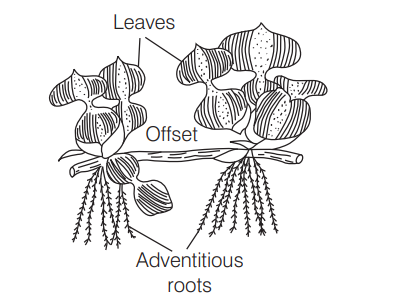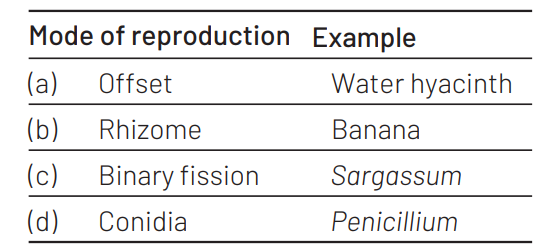Question
Genera like Selaginella and Salvinia produces two kinds of spores. Such plants are known as [NEET 2021]
(a) homosorus
(b)heterosorus
(c) homosporous
(d)heterosporous
Answer/Explanation
Ans. (d)
Heterosporous plants are the ones that produce two diverse sorts of spores, i.e. microspores and the megaspores. The microspores and megaspores germinate and give rise to male and female gametophyte in these plants and are retained on the parent sporophytes for variable periods, e.g. Selaginella and Salvinia.
Question
Vegetative propagule in Agave is termed as [NEET (Oct.) 2020]
(a) rhizome
(b) bulbil
(c) offset
(d) eye
Answer/Explanation
Ans. (b)
Vegetative propagule in Agave is bulbil. It develops as a small bud on the axial leaf and after falling on the soil, it develop into new plants.
Question
Strobili or cones are found in [NEET (Sep.) 2020]
(a) Pteris
(b) Marchantia
(c) Equisetum
(d) Salvinia
Answer/Explanation
Ans. (c)
Strobili or cones are found in Equisetum. Equisetum species have rhizomes that grow deep below the grounds surface. Some species have cone-like structures called strobili that produce and house the plants spores for reproduction.
Question
Which of the following statements is incorrect? [NEET (National) 2019]
(a) Claviceps is a source of many alkaloids and LSD
(b) Conidia are produced exogenously and ascospores endogenously
(c) Yeasts have filamentous bodies with long thread-like hyphae
(d) Morels and truffles are edible delicacies
Answer/Explanation
Ans. (c)
The statement “yeasts have filamentous bodies with long thread-like hyphae” is incorrect. Correct information about the statement is as follows.
Yeast is a unicellular sac fungus which lacks filamentous structures or hyphae. However, they may form short temporary filamentous structure called pseudomycelium. Rest statements are correct.
Question
Offsets are produced by [NEET 2018]
(a) parthenocarpy
(b) mitotic divisions
(c) meiotic divisions
(d) parthenogenesis
Answer/Explanation
Ans. (b)
Offsets are produced by mitotic divisions. They are one internode long runners that occur in some aquatic plants. Breaking of offsets helps in vegetative propagation. They give rise to new plants, e.g. Eichhornia. Meiotic divisions occur in only germ cells.Parthenocarpy is the development of seedless fruits. Parthenogenesis can be defined as the development of an egg into a complete individual without fertilisation.

Question
Which one of the following statements is not correct? [NEET 2016, Phase II]
(a) Offspring produced by the asexual reproduction are called clone
(b) Microscopic, motile asexual reproductive structures are called zoospores
(c) In potato, banana and ginger, the plantlets arise from the internodes present in the modified stem
(d) Water hyacinth, growing in the standing water, drains oxygen from water that leads to the death of fishes
Answer/Explanation
Ans. (c)
Statement (c) is incorrect as in potato, banana and ginger new plantlets always arise from the nodes of the modified stem. Internodes are the area between the two nodes.
Question
Which of the following pairs is not correctly match? [CBSE AIPMT 2015]

Answer/Explanation
Ans. (c)
The plant body Sargassum is a diploid sporophyte. It does not multiply asexually by means of spores. Instead it reproduce by vegetative means, i.e. fragmentation which is the only known method of vegetative reproduction in the free floating species of Sargassum.
Question
Which one of the following is correctly matched? [CBSE AIPMT 2012]
(a) Onion – Bulb
(b) Ginger – Sucker
(c) Chlamydomonas – Conidia
(d) Yeast – Zoospores
Answer/Explanation
Ans. (a)
The correctly matched pair is onion-bulb. Onion is a simple tunicated layered bulb while ginger is a straggling rhizome having uniparous cyme branching with sympodial axis. While yeast reproduces by budding and Chlamydomonas by zoospores.
Question
Which one of the following is correctly matched? [CBSE AIPMT 2012]
(a) Onion – Bulb
(b) Ginger – Sucker
(c) Chlamydomonas – Conidia
(d) Yeast – Zoospores
Answer/Explanation
Ans. (a)
Onion is a simple tunicated layered bulb while ginger is a straggling rhizome having uniparous cyme branching with sympodial axis.
Question
The ‘Eyes’ of the potato tuber are [CBSE AIPMT 2011]
(a) flower buds
(b) shoot buds
(c) axillary buds
(d) root buds
Answer/Explanation
Ans. (b)
Epimorphosis is the replacement of a lost organ of the body by proliferating new cells from the surface of the wound or injured part.
Morphogenesis (Gr. morphe=form and genesis=origin) is the growth, shaping and arrangement of body parts according to genetically predefined patterns. The extent direction and rate of morphogenesis depend on genetic controls and environmental factors.
Question
A population of genetically identical individuals, obtained from asexual reproduction is [CBSE AIPMT 1993]
(a) callus
(b) clone
(c) deme
(d) aggregate
Answer/Explanation
Ans. (b)
Clone refers to the population of genetically identical individuals obtained from asexual reproduction or produced vegetatively from single organism. An individual member of a clone is called ramete.
Question
Vegetative reproduction of Agave occurs through [CBSE AIPMT 1991]
(a) rhizome
(b) stolon
(c) bulbils
(d) sucker
Answer/Explanation
Ans. (c)
Vegetative propagation of Agave occurs by bulbils. These are condensed axillary bud capable of giving rise to shoots, i.e. independent plant.
